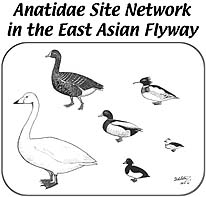
Introduction to the Network Sites
Utonai-ko
Hokkaido, Japan
[ in Japanese ] [ Back ]
[ What's New ] |
[ Site Network ] |
[ Action Plan ] |
[ Links ] |
[ Atlas ] |
[ Sitemap ] |
[ Japanese pages ] |
[ Network Sites ] |
[ Activities ] |
[ Introduction ] |
[ Contacts ] |
|
|
Introduction to the Network Sites Utonai-koHokkaido, Japan [ in Japanese ] [ Back ] |
|
The Utonai-ko is a freshwater lake in the riverbasin of Yufutsu-gawa in the central part of Hokkaido Island, 42°42'N, 141°43'E. It has 9km coast line. The site includes the lake and surrounding marshes and swamp forest, covering 510ha, as designated to Ramsar Site in 1991.
The lake is important wetland as a staging site of ducks, geese and swans which breeds Russian Far East and migrate south to winter in Japan. The number of White-fronted Goose Anser albifrons using the lake, especially during their northward migration in spring, has been growing up in recent years, such as from 30,000 geese in 1996 to 50,000 geese in 2001 spring. The number of 50,000 White-fronted Geese is estimated as c. 30% of its East Asian population. The flock roosts in the lake and use surrounding arable land for their food in the riverbasins of Yufutsu-gawa and Chitose-gawa.
Taiga Bean Goose A. fabalis middendorfi (up to 900 geese), Whooper Swan Cygnus cygnus (up to 500 swans), Bewick's Swan Cygnus bewickii (up to 500 swans) also regularly visit the lake. The numbers of Taiga Bean Goose and Bewick's Swan exceed 1% of East Asian population, respectively. These species use the lake for roost and for food. A part of Whooper Swan flock, up to 300 swans spend throughout the winter in the lake.
* | Status of Anatidae populations in the East Asian Flyway, based on the Waterbird Population Estimates -- Third Edition (Wetlands International 2002). |
As described above, the lake supports more than 20,000 Anatidae individuals (Criteria 1), and supports more than 1% of the East Asian populations of White-fronted Goose, Taiga Bean Goose, Bewick's Swan (Criteria 2).
Thirty-four Anatidae species have been recorded in the lake, among which 25 species regularly visit the lake. It includes these populations with the unfavourable conservation status, such as: Taiga Bean Goose (as shown above), Tundra Bean Goose A. fabalis serrirostris (up to 100), White-fronted Goose (as shown above), Snow Goose A. caerulescens (2-4 geese in spring and autumn since 1998).
The management authority of the Site is:
Tomakomai City Government, Public Health & Nature Preservation Division
5-6, Asahi-machi 4-chome, Tomakomai, Hokkaido, 053-8722 Japan
TEL +81-144-32-6111 / FAX 81-144-33-0474
http://www.city.tomakomai.hokkaido.jp
The facilities for the conservation / education in the Site:
|
|
|
|
|
Further information of the Site can be found on the internet at:
|
Activities in and around the site:
|
[ Top ] [ in Japanese ] [ Back ]
[ Network Sites ] |
[ Activities ] |
[ Introduction ] |
[ Contacts ] |
[ What's New ] |
[ Site Network ] |
[ Action Plan ] |
[ Links ] |
[ Atlas ] |
[ Sitemap ] |
[ Japanese pages ] |